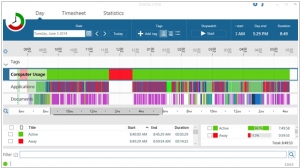Harvest vs ManicTime
June 20, 2023 | Author: Adam Levine
9

Simple time tracking, fast online invoicing, and powerful reporting software. Simplify employee timesheets and billing. Get started for free. Whether it’s from the web, your smartphone or another application, it’s never been so easy to track time. With a simple, intuitive interface, getting you and your team on board is fast and easy. Harvest’s powerful reporting gives you real-time access to keep your projects on time and on budget.
1

Manictime sits in the background and records your activities, so you can just forget it is there and focus on your work. When you are finished you can use collected data to accurately keep track of your time. After you have finished working, you can use MT to keep track of your hours. That means no more "punch-clock" like software, where you always forget to start or stop the clock. Just sit back and do your work. After you are finished, you can easily use collected data to accurately keep track of your time.
Harvest and ManicTime are both time tracking software, but they have notable differences in terms of their features and target users:
1. Features: Harvest offers comprehensive time tracking features, including manual time entry, timers, timesheet management, and expense tracking. It also provides project management functionalities, invoicing, and integrations with other software tools. Harvest focuses on simplifying time tracking and project management processes. ManicTime, on the other hand, is more focused on automatic time tracking. It tracks user activity on the computer and provides detailed reports on applications used, websites visited, and overall productivity. ManicTime emphasizes analyzing work patterns and improving time management.
2. Tracking Method: Harvest primarily relies on manual time entry or starting/stopping timers to track time spent on tasks or projects. Users manually enter their hours or use timers to track their work. ManicTime, on the other hand, automatically tracks computer usage in the background, capturing the time spent on different activities without requiring manual intervention. It provides a more passive and automated approach to time tracking.
3. Reporting and Analytics: Harvest offers robust reporting features, allowing users to generate detailed reports on time spent, billable hours, project budgets, and team productivity. It provides insights into project profitability and resource allocation. ManicTime provides detailed activity logs and reports that can help individuals analyze their work patterns, identify time-wasting activities, and optimize productivity.
4. Target Users: Harvest caters to a wide range of users, including freelancers, small businesses, and teams within larger organizations. It provides features for team collaboration, project budgeting, and client management. ManicTime is suitable for individuals or organizations that want to analyze their computer usage and improve time management.
5. Pricing: Harvest offers subscription-based pricing plans based on the number of users and features needed. It provides a free plan for solo users and a range of paid plans for teams. ManicTime offers both free and paid plans with additional features, allowing users to track their time and productivity without significant financial investment.
See also: Top 10 Time Trackers
1. Features: Harvest offers comprehensive time tracking features, including manual time entry, timers, timesheet management, and expense tracking. It also provides project management functionalities, invoicing, and integrations with other software tools. Harvest focuses on simplifying time tracking and project management processes. ManicTime, on the other hand, is more focused on automatic time tracking. It tracks user activity on the computer and provides detailed reports on applications used, websites visited, and overall productivity. ManicTime emphasizes analyzing work patterns and improving time management.
2. Tracking Method: Harvest primarily relies on manual time entry or starting/stopping timers to track time spent on tasks or projects. Users manually enter their hours or use timers to track their work. ManicTime, on the other hand, automatically tracks computer usage in the background, capturing the time spent on different activities without requiring manual intervention. It provides a more passive and automated approach to time tracking.
3. Reporting and Analytics: Harvest offers robust reporting features, allowing users to generate detailed reports on time spent, billable hours, project budgets, and team productivity. It provides insights into project profitability and resource allocation. ManicTime provides detailed activity logs and reports that can help individuals analyze their work patterns, identify time-wasting activities, and optimize productivity.
4. Target Users: Harvest caters to a wide range of users, including freelancers, small businesses, and teams within larger organizations. It provides features for team collaboration, project budgeting, and client management. ManicTime is suitable for individuals or organizations that want to analyze their computer usage and improve time management.
5. Pricing: Harvest offers subscription-based pricing plans based on the number of users and features needed. It provides a free plan for solo users and a range of paid plans for teams. ManicTime offers both free and paid plans with additional features, allowing users to track their time and productivity without significant financial investment.
See also: Top 10 Time Trackers


